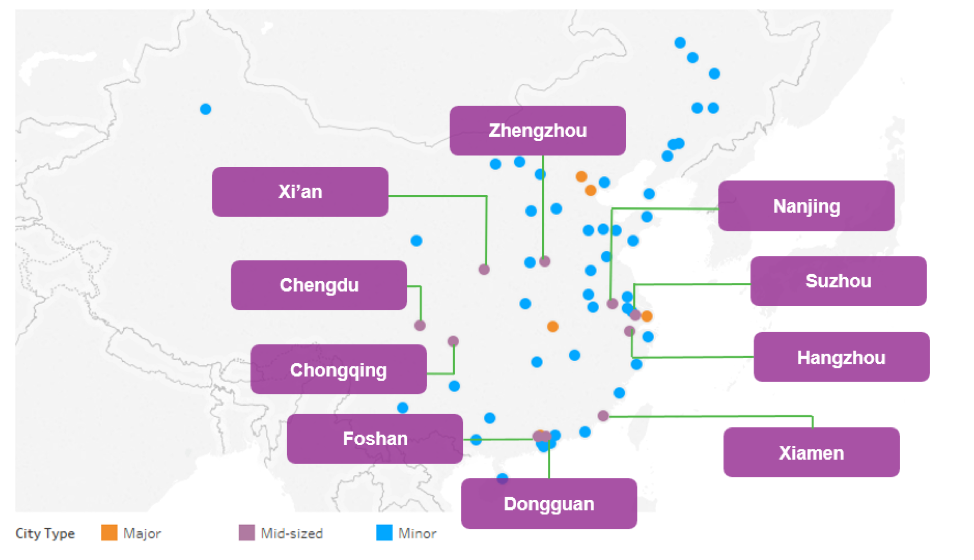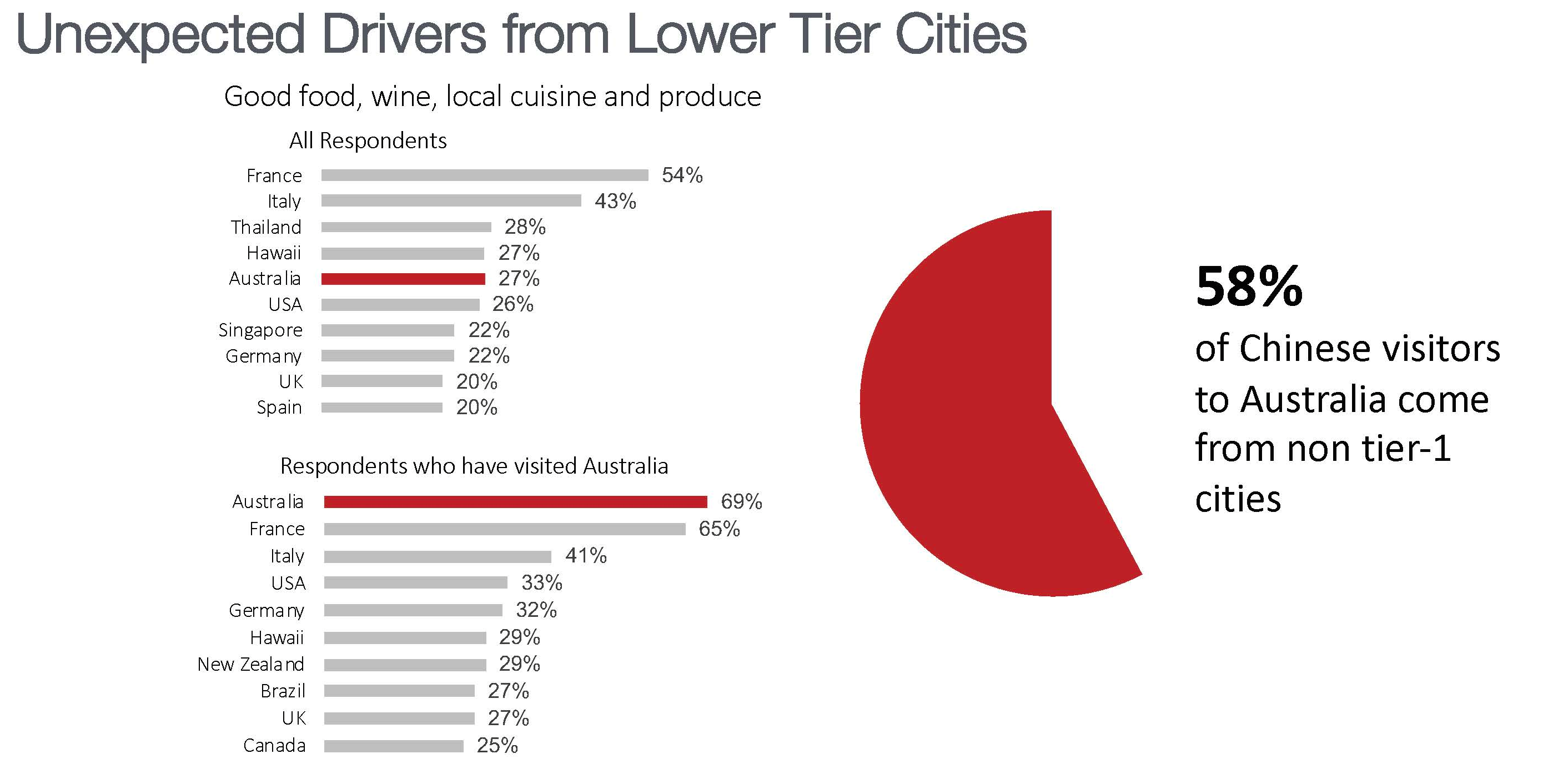-
There are 114 cities in China with populations bigger than that of Melbourne, Australia. The east-coast province of Jiangsu, for example, has an economy the same as Australia the country.
For international brands seeking to enter the Chinese market and achieve global growth, starting with China’s well-known megacities like Beijing and Shanghai is the usual and likely approach.
"In the coming decade China’s smaller urban centres are likely to be at the forefront of driving growth and consumer spending.”
China’s domestic retail market is growing exponentially. Fuelled by ongoing income growth and a booming e-commerce sector, the World Economic Forum predicts China will have the world’s largest middle class in the next ten years, becoming the largest consumer market globally.
Changing consumption patterns and consumer preferences are also driving demand for many of the premium, ‘clean, green, and safe’ products Australian brands are well known for.
Yet while they still warrant consideration, the large economies of Shanghai and Beijing in many product categories and industry segments have already become saturated markets - and amongst the most competitive and hotly contested marketplaces globally.
In the coming decade, China’s smaller urban centres are likely to be at the forefront of driving growth and consumer spending.
In fact, around 166 million Chinese are expected to move from rural to urban areas in the next 14 years, with 75 per cent of these people headed towards the lesser- known, ‘lower-tier cities’ according to research by Morgan Stanley.
Unsurprisingly a growing number of Australian and international businesses are seeking to understand and unlock potential in lower-tier cities. These cities may be ‘smaller’ by China’s standards but in many cases have populations and markets larger than some countries.
More than a single market
{CF_IMAGE}
China has over 600 cities which differ considerably in terms of demographics, economic activity, consumer behaviour and local infrastructure, not to mention geography and climate.
While there is no ‘official’ list for classifying these cities they are typically divided into four hierarchical tiers based on GDP, population, political administration as well as levels of services and infrastructure.
This tiered system has become a popular framework for both local and international businesses, as it recognises no two cities, and indeed no two local markets in China are the same.
{CF_IMAGE}
Tier-one cities including Beijing, Shanghai, Guangzhou and Shenzhen, encompass the most developed economies within China, with the most affluent middle class consumers.
These highly populated urban metropolises are not only China’s most famous centers but often yield strong economic, cultural and political clout.
Consumers in these tier-one cities are often the most sophisticated, internationally engaged and frequent purchasers of imported products. But with around 500 new product launches taking place in these metropolises on a daily basis, getting noticed and winning new customers is challenging.
{CF_IMAGE}
Beyond tier one
How can businesses look beyond the obvious tier-one cities when it comes to marketing their products in China?
The rapidly expanding consumer classes in the lower-tier cities are typically less ‘bombarded’ by product marketing, have less product choice and are more receptive to quality imported offerings.
China Skinny managing director Mark Tanner says China’s food and beverage sector, for instance, is growing three times faster in these lower-tier cities, compared to in tier-one counterparts.
Consumer product brand owners, especially sportswear and jewelry, are also among the sectors are well placed to benefit from rising incomes in the lower-tier locations, as are brands offering entertainment products and experiences like travel or going to the movies.
The emerging category of consumers in China’s lower-tier cities are often millennials.
“They’re earning more, they’re much more willing to spend…and they’re online, they’re not using traditional channels they’re on WeChat and using e-commerce channels,” Tanner says.
{CF_IMAGE}
Localising products for different geographic markets
The differences between individual cities and provinces can be stark, impacting on everything from disposable income levels to spending habits and consumer preferences and behaviour.
These fundamental differences require careful nuancing by marketers. A skincare or cosmetics brand, for example, will need to offer different products for shoppers in the dry north of China, compared to the more tropical south.
One important element often overlooked by marketers is the link between lower tier cities and tourism.
Tanner points to a study by Tourism Australia which found 69 per cent of Chinese consumers who had visited Australia had a very favourable impression of Australian products, compared with 27 per cent of the population overall.
With a growing number of tourists from the lower-tier cities, strong links are being created which can be carefully leveraged by savvy marketers.
When it comes to localising a consumer product strong knowledge of the target market - right down to a city level understanding - is critical.
As more and more businesses look to win new customers in the emerging lower-tier cities, localising a business approach and engaging with potential growth markets beyond China’s tier-one regions - with careful assessment of consumer preferences lifestyles, climate and travel habits - will open new China market growth opportunities.
Nick Henderson is director of the China Practice at Asialink Business, Australia’s National Centre for Asia Capability.
The views and opinions expressed in this communication are those of the author and may not necessarily state or reflect those of ANZ.
-
-
-
-
anzcomau:Bluenotes/asia-pacific-region,anzcomau:Bluenotes/global-economy
There’s more to China than Beijing
2018-10-01
/content/dam/anzcomau/bluenotes/images/articles/2018/October/Picture%205.jpg
EDITOR'S PICKS
-
The Guangdong-Hong Kong-Macao Greater Bay Area is a recipe for China’s global integration plan.
7 May 2018 -
Market access in China is the first step towards export opportunities for Australian agribiz.
28 March 2018




